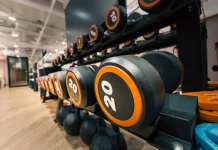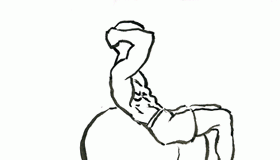Last Updated on September 25, 2014
When it comes to effective leg workouts, leg extensions hold a prime position for isolating and strengthening the quadriceps—the large muscles at the front of your thighs. Leg extensions, performed with a leg extension machine, are an accessible, targeted exercise for anyone looking to enhance leg muscle definition, knee strength, and athletic performance.
This guide will cover everything you need to know about performing leg extensions with proper form, highlight the benefits, discuss variations to maximize effectiveness, and address common mistakes to avoid. Whether you’re a beginner or a seasoned athlete, read on to master the leg extension exercise.
Benefits of Leg Extensions
- Quadriceps Isolation
Leg extensions focus specifically on your quadriceps, allowing for targeted muscle engagement without involving the glutes, hamstrings, or other muscle groups. This isolation is essential for individuals who want to build or define the front of their thighs. - Enhanced Knee Strength
By strengthening the quadriceps, leg extensions help stabilize the knee joint. A strong quadriceps supports better knee function, making this exercise beneficial for those recovering from knee injuries or aiming to prevent knee issues. - Improved Athletic Performance
Strong quadriceps are critical for activities like running, cycling, and jumping. Adding leg extensions to your routine can improve leg power, endurance, and balance, helping you excel in various physical pursuits. - Beginner-Friendly
Leg extensions provide guided, controlled movements that make them accessible to beginners. They are a great starting point for individuals who are new to strength training and want to build foundational leg strength.
How to Perform Leg Extensions Properly
Follow these steps to execute leg extensions with optimal form:
- Adjust the Machine
Start by adjusting the seat of the leg extension machine to align your knees with the machine’s pivot point. This setup allows a full range of motion for your knees and ensures that the footpad fits comfortably just above your ankles. Adjusting the seat properly is crucial for effective muscle engagement and injury prevention. - Position Yourself
Sit back against the seat with your hips and lower back supported. Grasp the handles beside the seat to stabilize your upper body throughout the movement. Keep your feet under the footpad with your ankles flexed at a 90-degree angle. - Extend Your Legs
Begin the exercise by exhaling as you extend your legs. Slowly straighten your knees and lift the weight until your legs are fully extended. Avoid locking your knees at the top of the movement to protect the knee joints. Instead, keep a slight bend and pause for a second to feel the quadriceps contraction. - Return to Starting Position
Inhale as you carefully lower the weight by bending your knees, returning to the starting position in a controlled manner. Keep your movements smooth and steady, avoiding any sudden drops or jerks. - Maintain Controlled Movements
Avoid swinging or using momentum to lift the weight. The slower and more controlled your movement, the greater the muscle engagement and benefits.
Pro Tip: Start with a lighter weight to get used to the motion, especially if you’re new to the exercise. Gradually increase the weight as your form and strength improve.
Tips for Effective Leg Extensions
- Control the Tempo
Focus on a slow, controlled tempo to maximize muscle tension and effectiveness. Rushing through the exercise decreases its impact and increases the risk of injury. - Choose the Right Weight
Avoid lifting too much weight, which can compromise your form. Start with a weight you can lift for 10-12 repetitions with proper technique and increase as your strength improves. - Use Proper Breathing Technique
Exhale during the lifting phase (extension) and inhale as you lower the weight. Proper breathing supports core stability and improves performance. - Avoid Full Knee Lockout
Locking out your knees can stress the joint unnecessarily. Aim to keep a slight bend at the top of the movement for optimal muscle engagement. - Incorporate Into Routine
Leg extensions are ideal as a warm-up to activate the quadriceps before compound leg exercises like squats or lunges. Alternatively, use them as a finisher at the end of your workout to fully fatigue your quads.
Common Mistakes to Avoid
- Using Excessive Weight
Lifting too heavy can lead to poor form, knee strain, and reduced muscle engagement. Always prioritize technique over the weight. - Swinging the Weight
Momentum-based movements reduce the effectiveness of the exercise. Focus on a controlled lift and descent for maximum quadriceps activation. - Incorrect Seat Position
Failing to align your knees with the machine’s pivot can lead to knee discomfort and reduced effectiveness. Adjust the seat for a snug fit and proper alignment. - Neglecting Warm-Up
Before you begin leg extensions, warm up with light cardio or dynamic stretches. This preps your muscles and joints for the exercise, reducing injury risk.
Variations of Leg Extensions
Add variety to your workout routine by trying these leg extension variations:
- Single-Leg Extensions
Perform leg extensions one leg at a time to focus on each quadriceps individually. This variation helps address muscle imbalances and improves unilateral strength. - Resistance Band Leg Extensions
If you don’t have access to a leg extension machine, use a resistance band to perform the movement. Anchor the band to a sturdy object and loop it around your ankle, extending your leg in a similar motion. - Weighted Ankle Leg Extensions
Attach ankle weights and perform leg extensions while seated on a bench or chair. This option is a practical alternative if you’re training at home. - Negative Leg Extensions
Focus on the lowering phase of the movement by using a slightly heavier weight. Raise the weight with both legs, then slowly lower with one leg to increase muscle tension.
Incorporating Leg Extensions Into Your Workout
Depending on your fitness goals, here’s how to add leg extensions to your routine effectively:
- Warm-Up Exercise
Start your workout with light leg extensions to warm up the quadriceps. This helps activate the muscles and prepares them for more intense exercises. - Finisher Exercise
Use leg extensions at the end of your workout to fatigue the quads fully. Aim for 3-4 sets of 15-20 reps at a moderate weight. - In Supersets
Pair leg extensions with hamstring exercises (like hamstring curls) in supersets to target both the front and back of your thighs, ensuring balanced leg development. - Hypertrophy Focus
For muscle growth, perform 4 sets of 8-12 reps with a heavier weight. This rep range maximizes muscle tension, leading to increased size and strength over time. - Endurance Focus
If endurance is your goal, perform 2-3 sets of 20-25 reps with a lighter weight. This approach builds muscular endurance, which benefits endurance sports and activities.
Safety Considerations for Leg Extensions
- Consult a Professional
If you have existing knee issues, consult a fitness professional or physical therapist before incorporating leg extensions into your routine. - Listen to Your Body
If you feel pain (other than muscle fatigue) during the exercise, stop immediately. Double-check your form and consider reducing the weight or reps. - Avoid Locking Out
Keep a slight bend in your knees at the top of the movement. This reduces pressure on the joint and ensures the tension remains in your quadriceps. - Focus on Core Stability
Engage your core throughout the exercise to help support your lower back and prevent unnecessary strain. - Progress Gradually
Avoid increasing weight too quickly. Gradual progress is essential to avoid injury and maintain proper form.
Frequently Asked Questions
Q1: How often should I do leg extensions?
A: For best results, include leg extensions in your leg day routine 1-2 times per week, allowing 48 hours of recovery between sessions.
Q2: Are leg extensions bad for my knees?
A: When performed correctly, leg extensions can strengthen the muscles around the knee, enhancing joint stability. However, if you have pre-existing knee issues, consult a professional before adding them to your routine.
Q3: What muscles do leg extensions target?
A: Leg extensions primarily target the quadriceps, but they also engage the knee stabilizers, contributing to overall knee health.
Q4: Can I do leg extensions at home?
A: Yes! You can perform leg extensions at home using resistance bands or ankle weights to simulate the movement.
Elevate Your Leg Day with Leg Extensions
Leg extensions are an excellent addition to any leg day routine, allowing for focused quadriceps work, enhanced knee stability, and improved athletic performance. By following proper form, avoiding common mistakes, and experimenting with variations, you can make the most of this staple exercise.
Include leg extensions in your fitness regimen to achieve strong, well-defined legs that support your overall fitness goals.






